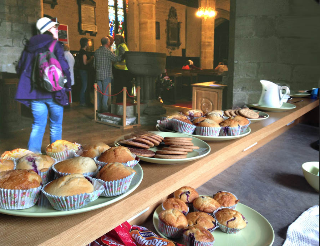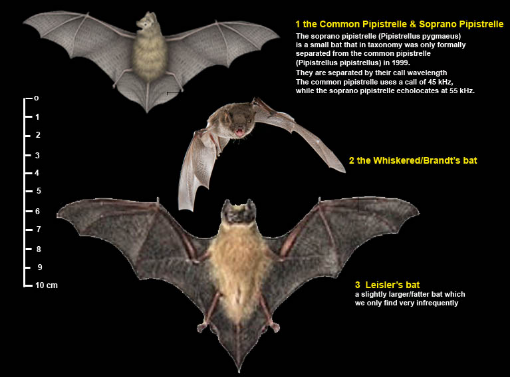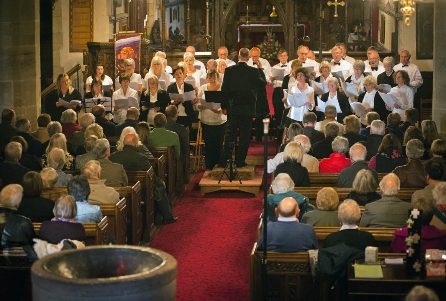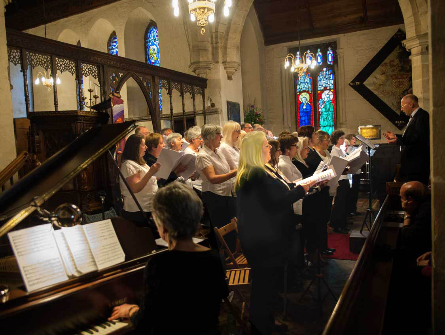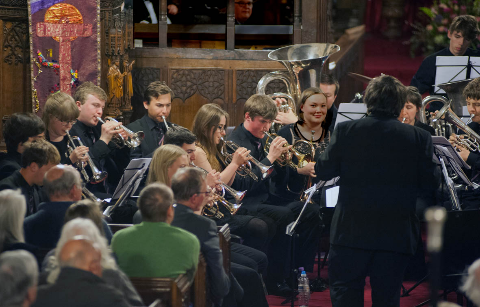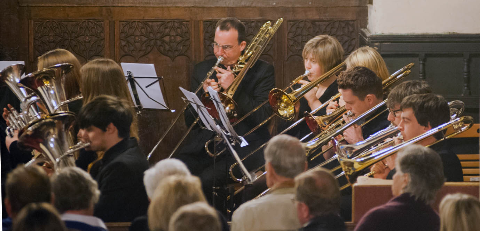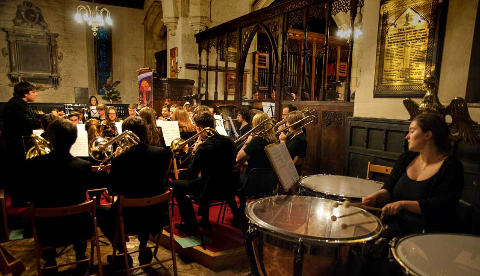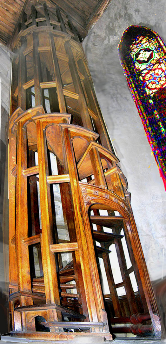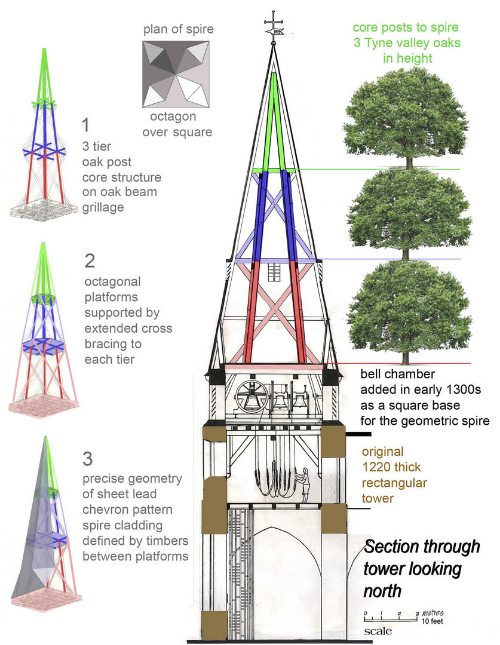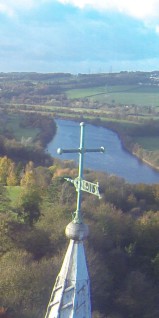The Friends of Holy Cross Ryton
No longer active, The Friends was a body of people (registered as a charity), most of whom not members of Holy Cross Church, who supported the maintenance, restoration and development of our Grade One Listed gem of a parish church, through annual subscriptions and by hosting social and cultural events, notably the Spring Concert.
Over the years they raised over £30,000 for conservation building works, installation of essential new drainage, paid the professional fees for an architect accredited in building conservation to design and supervise installation of the recent internal comfort facilities and the cost of this web site. Although the group has now been dissolved, this page remains as a testament to the wonderful work The Friends undertook over many years, for which we continue to be thankful.
WORKS UNDERTAKEN AT HOLY CROSS DURING SPRING 2017
The Friends are pleased to have contributed to the funding of
- the complete re-wiring of Holy Cross church including the refurbishment of the original gas chandeliers in the nave incorporating dimable LEDs
- the current reslating of the roof to the north aisle in Westmorland green slates; replacing rottin batterns, laminating Scotch slates and hopefully curing leaks to the parapet gutter linings.
2016 MONTH BY MONTH
(the 2015 monthly blog can be found by clicking here)
June at Holy Cross, Ryton
We received this email from Mic Porter after the Hirings:
Dear Friends of Holy Cross Ryton,
I visited your Church during The Hirings and again a couple of weeks later and on both occasions asked about the (?)plaster frieze that is held to the wall on the south side of the Choir stalls. Those that I spoke to knew little about it except ..... it could be the arms of Bernard Gilpin [of Houghton le Spring] but why might he be commemorated in Ryton and for how long has he been?
I was also unable to interpret the inscription.
Would it would be possible to use your website to solicit a fuller explanation of the panel and hope that others in the Ryton community might know more?
I look forward to learning more about the item.
With best wishes,
Mic Porter
Thank you Mic for reminding us to follow this up. Exploiting the benefit of the early morning sun's shadow, I took this photo on 21 June :
And here is a link to the excellent Houghton le Spring local history website http://www.houghtonlespring.org.uk/gilpin/
Note the Gilpin Crest of the hog, crescent moon and oak used as the site's heading; I've extracted the following:
“THE APOSTLE OF THE NORTH
Bernard Gilpin was Rector of Houghton-le-Spring from 1558 until his death in March 1583 at the age of 66 years.
Houghton was known as a "fat parish" covering more than sixteen villages and Gilpin's salary reflected this: at £400 per annum, the equivalent of £68,000 in today's money, it was considered a large amount of money.
Nevertheless, Bernard Gilpin was a generous man; every Sunday, between Michaelmas (Houghton Feast) and Easter, he would open up the Rectory and feed the parish's poor with a roasted hog or ox.
The following inscription can be found in raised letters:
BERNARD GILPIN RECTOR HVIVS ECCLIOE –
OBIIT QVARTO DIE MARTII AN DOM. 1583.oks
it translates as:
Bernard Gilpin, Rector of this Church, died on the 4th day of March in the year of our Lord 1583”
[end of extract]
Perhaps Archdeacon Thorp (1783-1862) had this cast of the end of the box tomb made while he was responsible for upkeep and restoration of church fabric throughout the Durham Diocese from the Tees up to the Tweed (prior to 1882). There are not a few fragments that he collected distributed through the church, built in around the village and into his retirement project Dene Head House.
The plaque looks to have been mounted in the choir over the metal casting with the raised lettering, after the 1886 restoration during which the chancel roof was totally rebuilt.
dh
May at Holy Cross, Ryton
Ryton Hirings Saturday 28 May
The afternoon of the Ryton Hirings organised by Ryton Lions Club was warm and sunny with an excellent turnout.
The Friends were on duty in Holy Cross Church serving refreshments with several as bellringers encouraging visitors to climb the spectacular stair up to a demonstration in the Ringing chamber hoping to recruit new ringers.
Bats in the Belfry ?
We had to be in attendance for an ecologist and her team to check on the bats flying around Holy Cross church one evening in late May.
They each had a device that displays a readout of the bats' echolocation calls in Hertz, from which they can identify the species.
The four species of bats identified are shown in the this diagram.
On Hearing the First Cuckoo of Spring
Last May I wrote
"The only thing I miss is the sound of the cuckoo; I haven’t heard one here for nearly 20 years."
I'd like to record that at 05.30H on May Bank Holiday morning 2nd May 2016, I heard a cuckoo call six times loud and clear in the dawn. The call seemed to come from the trees just beyond the Parish hall on the slopes up to the Grove.
I haven't heard it since; perhaps it flew on further north to the safer lands in the Borders having heard about our local (Toon army) Magpies .
The Friends' Spring Concert, 30th April
At last a real Spring night with an overflowing capacity audience gathering expectantly. As the sunset, we were in for two very different musical experiences.
It was the last concert to be organised by Pat Hobson and she had persuaded Ovingham and District Choir (some of whose members live in Ryton) to give us their rendering of Faure's Requiem.
The unmistakeable opening chords rang out and we were treated to a memorable performance. Surprising to me was how the choirmaster Paul R Davies turned to also be the leading baritone soloist and we had some pure soprano singing with an outstanding soloist Rachel Armatage from within the choir.
After the interval Durham University’s student band could not have been a greater contrast.
Not only was the opening volume of sound in Copeland’s ‘Fanfare for the Common Man’ a profound shock, a second realisation was that the band was so beautifully modulated.
There was an extraordinary range between volume of sound, tone and musical colour. The quiet reflective moments were the real surprise to me, remembering our Pennine mill village brass band heding the Boy Scout‘s church parade on a wet Sunday morning.
Especially poignant was the Pitmen’s March inspired by the memorial in the Cathedral south aisle to Durham miners who lost their lives.
Our own slate slab by the driveway outside commemorates the Stargate Explosion of 30th May, 1826 when 38 men and boys were killed, very nearly 216 years ago.
A very big thank you so much to both groups who so generously gave of their talents.
After payment of expenses, Richard, the Friend's Treasurer, says over £1000 was raised for the maintenance of Holy Cross church Ryton.
Pat Hobson as Impressario will be a hard act to follow.
We are most grateful to Ryton Camera Club for the above photographs.
February 2016
Last month we explored the spire, this month we look more closely at the stair up to the tower.
Most people entering the church for the first time and looking around will fix on this spectacular stair in the south west corner of the tower spiralling up into space.
"Wow!" They exclaim. “When was that made?”
Maybe from a liturgical point of view it upstages the more spiritual features of a mediaeval gothic church – the view eastwards; the pulpit, screen and the chancel. .
The stair dates from 1886, when an extension for vestries over a cellar boiler house and a fine Lewis organ were also added to the north east of the church.
It was the work of Hodgson-Fowler the Durham ecclesiastical architect and there is a similar but smaller one in Durham Castle.
The Pevsner Buildings of England volume on County Durham says the stair is “essentially a scaffolding of long, close-set uprights with occasional cross-bars and the treads to stress the horizontals, an example of how courageous new work can improve even a venerable building of the C13” (Pevsner & Williamson 1983, 393).
Like the mast of a sailing ship the centre of the stair is a stout pine post, perhaps from the Baltic. From it the stair treads radiate to the external verticals which are of polished oak, fluted on their projecting edges.
What I notice every time I ascend as a bellringer is
- the stair turns clockwise in its ascent as is traditional in defending castles from attack from below !
- how carefully the oak horizontal cross pieces have been placed to provide a shaped hand hold as well as providing the necessary structural integrity.
dh
January 2016
In this New Year I‘m resolving to try to communicate in our monthly Friends’ page something of my enthusiasm for our Grade 1 Listed church building.
I could not start anywhere else but with the spire - Ryton's most prominent landmark. But I’m a bit late with my posting because I found analysing the spire’s geometry incredibly complex. I hope the diagrams I've posted below do the job for me.
Its easy enough to grasp the history: the 1220 church had been burnt when 'Braveheart' William Wallace with his Scots army sacked the village in 1298, and the blackened ruin of the fortified tower needed to be rebuilt in the early 1300s.
But the Durham masons and carpenters were truly ‘inspired’ – determined to raise something very special.
Outwardly the striking lead spire interacts dramatically with our often grey skies. The lead is symbolic too, for the spire marks the end of the lead road down from the hills. Here at the limit of the tide on the Tyne, the lead was transferred at the Willows from packhorses onto the water for shipping away by sea to roof Europe and London.
Inwardly the spire is anything but simple. Hidden away is the most elegantly conceived 3D timber structure supporting the heavy chevron pattern leadwork precision geometry.
All this was worked out in the early 1300s by scratching and scoring out the geometry on a mud/lime floor...I can barely get my head around it using a computer!
dh
The internal structure was surveyed and plotted in CAD nearly 20 years ago while we were bidding to install the Millennium Ring of 8 bells. It is sad that less than a handfull of Rytonians have experienced it.
The complex geometry might partly be explained by recalling that by 1300 the Crusades had resulted in a transfer to Europe of the Muslims’ advanced mathematical understanding of abstract geometries and patterns - developed because their Faith forbade figurative art.
Muslims wove extraordinarily intricate carpet patterns and erected the most complex ceramic tiled architectural vaults, while Christians worked at painting and sculpting Holy figures and developing an understandng of anatomy.
The 2015 Friends' month by month blog entries
can be found by clicking here)
Visits to The Friends pages since 5 March 2015:

